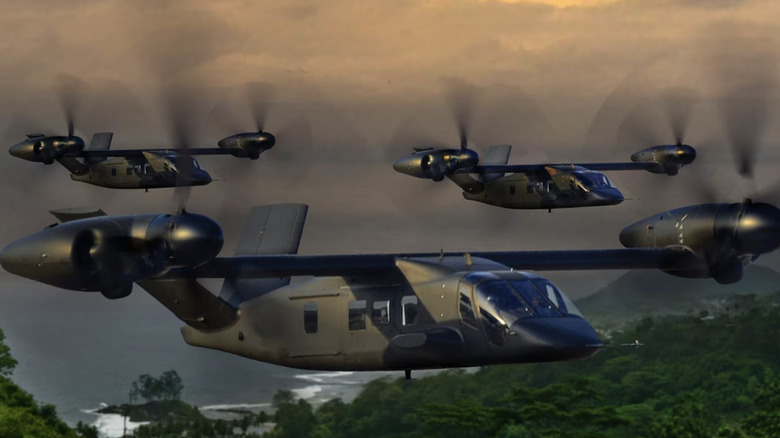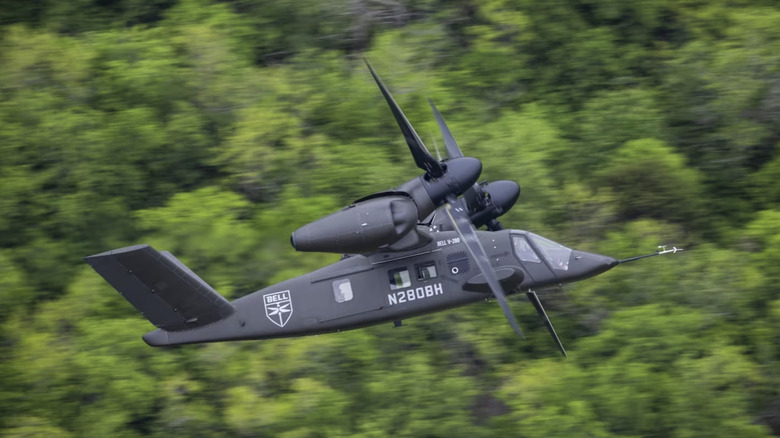What Limits The Top Speed Of Many Helicopters & How Does The V-280 Valor Solve It?
Helicopters are incredible machines with amazing capabilities that fixed-wing aircraft do not have. In spite of this, however, helicopters also have limitations — most notably, the maximum speed they can achieve. This is a result of several factors, including the physics of the rotors, retreating blade stall, engine power, and structural constraints. Addressing the weaknesses of helicopters, newer aircraft like the V-280 Valor use a tilt-rotor design, which is more efficient and gives better performance compared to the rotary-wing design.
Depending on its type, the maximum speed of helicopters can vary from 135 mph up to 291 mph. Helicopters are hindered from achieving faster speeds because of the rotor's mechanics, and every one has a mandated VNE or maximum speed allowed, which must not be exceeded to avoid potential failure. One of the primary reasons is the instability caused by a retreating blade stall, which happens when one side of the rotor loses lift at high speeds. Alongside this, a helicopter's performance is also limited by structural limitations on its airframe and the total power that is produced by its engine.
The tiltrotor system of the V-280 Valor combines the strengths of fixed-wing aircraft and rotary-wing aircraft. Compared to conventional helicopters, tiltrotors have a number of advantages, the most important among them being speed, range, and the capacity to function as both an aeroplane and a helicopter. The V-280, being a tiltrotor aircraft, has the ability to take off and land vertically, cruise at higher altitudes, and reach faster speeds.
Combining the best of both types
The Future Long-Range Assault Aircraft (FLRAA) program was started by the United States Army in 2009, designed to field a replacement to take over the roles performed by the Sikorsky UH-60 Black Hawk utility helicopter, a military workhorse that's been in service since the 1970s. Selected as the winner of the FLRAA competition, the V-280 Valor from Bell Textron beat out the Defiant-X, which was the Lockheed Martin Sikorsky and Boeing entry.
Bell Textron was formally awarded the contract in December of 2022, after the U.S. Army selected the V-280 to meet the requirements of their program. When contrasted to the coaxial Defiant-X, the V-280 Valor had greater top speed, maximum range, and better manoeuvrability during high-altitude and high-speed operations. In addition, despite being over double the price of the Defiant-X, the tilt rotor design of the V-280 allowed for more crew-carrying capacity at longer ranges than the Blackhawk it is going to replace, which for the army meant better value.
These performance advantages of the V-280 are a result of the lower power consumption required by a tiltrotor aircraft. The blade rotors on a helicopter need to do two things: produce the lift to get the helicopter airborne, and then provide the power to produce forward thrust. As a result, a helicopter's cruising power requirement is 2.7 times that of a tiltrotor, making it difficult to attain speeds above 175 mph. In comparison, tiltrotor aircraft can easily reach speeds of 290 mph.
The aircraft of the future
The reason helicopters can hover, take off, and fly in any direction is because of the lift, control, and propulsion produced by tilting its rotors. However, this ingenious mechanism is also prone to aerodynamic imbalances. Furthermore, the complex blade, hub, and linkage systems that compose a helicopter rotor must function seamlessly for it to fly, and subjecting such an intricate system to continuous motion and fluctuating aerodynamic loads increases the likelihood of failure. Tiltrotor aircraft don't suffer in the same way.
And as we mentioned before, tiltrotor aircraft are also generally faster. Among helicopters, the two fastest are the Eurocopter X3 with a top speed of 293 mph, and the Westland Lynx, which can go up to 249 mph. Compare these to the top speed of the fastest tiltrotor aircraft, the Leonardo AW609, which has a top speed of 317 mph, and the 315 mph of the Bell-Boeing V-22 Osprey; there is a wide difference in maximum velocities.
Because of their exceptional capacity to switch between vertical and horizontal flight, many consider tiltrotors the aircraft of the future. By being able to utilize the best characteristics of helicopters and airplanes, they have a lot of potential military applications, especially concerning rescue and logistics. The tiltrotor aircraft is an important evolution in air transport, but because of the cost, adoption has been slow. As it stands, until manufacturers are able to scale their platforms for tiltrotors to become more economical, it will take time before aircraft like the V-280 completely replace all helicopters.


